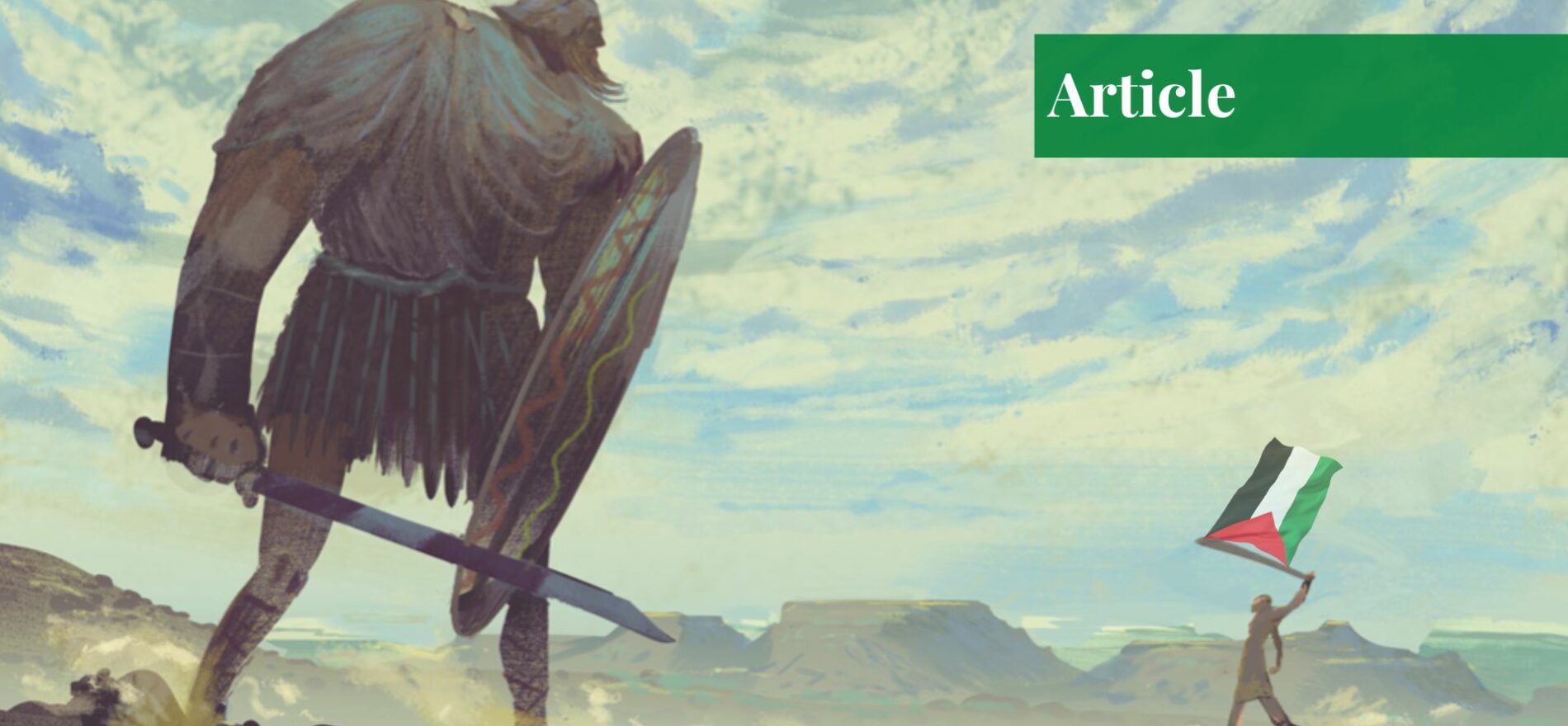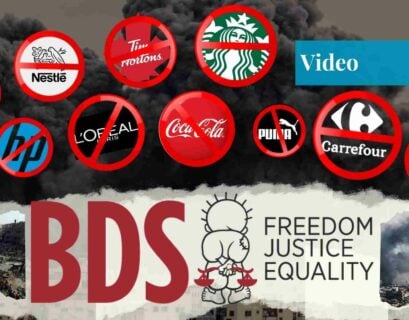Sarmad Ishfaq is an independent researcher and writer whose work has been published by Harvard Kennedy School Review, The Diplomat, Open Democracy, Paradigm Shift, Mondoweiss, and Eurasia Review to name a few. He has also been published by several international peer-reviewed journals such as Taylor and Francis' Social Identities. Before becoming an independent writer, he worked as a research fellow for the Lahore Center for Peace Research. He has a master's degree in International Relations from the University of Wollongong in Dubai where he was recognized as the 'Top Graduate'.
Introduction
If one has followed objective reporting on the animosity-filled skirmishes between Palestine and Israel, it becomes clear that the Palestinians have suffered far more in terms of human losses and otherwise in relation to the Israelis. Although there might be several explanations for this reality, the primary reason undoubtedly is the vast difference in military strengths between Israel and Palestine.
While Israel boasts an impressive and technologically advanced military (i.e., the Israel Defense Forces), Palestine’s de facto fighting force is rudimentary at best. In fact, the disparity is so colossal that the military conflict between the two sides cannot really be called a conflict in a fair sense as Palestine does not even possess an official land army, air force, or navy.
In a sense, this is not a secret. Writing for the New York Times this past May, Mona El-Naggar alluded to this reality stating that “the arsenal [of Hamas & Islamic Jihad] pales in comparison to the vast destructive powers of Israel’s air force.” And yet while the mainstream media is cognizant of the military discrepancy between both sides, the consequences of this discrepancy are almost never commented on.
This piece aims to remedy that not only by delineating the military mismatch of Israel’s Goliath to Palestine’s David but also by highlighting the tragic consequences of such a discrepancy i.e the overwhelming casualties of the Palestinian people.
Israel’s Military Strength
Israel has one of the world’s most advanced and battle-hardened military forces in the Israeli Defense Forces (IDF) that has enjoyed success in a myriad of conflicts. Winning most wars and conflicts since 1948 especially those against numerous foes, the IDF is a force to reckon with. The IDF was ranked 20th out of 140 countries in military strength by Global Firepower (GFP) in 2021.
Israel’s total military personnel is 643,000, with 170,000 active and 465,000 in reserves. There is 8,000 paramilitary personnel as well. There are also over 3 million Israelis who are fit for service. While the Arab states were the primary threats to Israel initially, this changed due to Israel’s peace treaties with Egypt (in 1979) and Jordan (in 1994)—the normalization deals with other Arab states in the Trump era have also helped secure Israel externally.
Armed groups such as the Palestinian Liberation Organization (PLO) and Fatah were threats in the 1960s but later renounced violence. This military vacuum was eventually filled by Hamas and Palestinian Islamic Jihad, both of which are spearheading the Palestinian freedom movement today. These armed groups have become the raison d’être for the IDF in contemporary memory, especially during the First and Second Intifadas, Operation Defensive Shield, the 2008 Gaza War, and Operation Cast Lead among others.
Currently, the Israeli Ground Forces have 1,650 tanks, which includes one of the best tanks ever produced, the Merkava Mk II/III/IV. The country also possesses 7,500 armored vehicles (which includes the Achzarit), 650 self-propelled artillery guns as well as 300 towed artillery weapons. Furthermore, many Israeli tanks and armored vehicles are equipped with a state-of-the-art “trophy” system.
The trophy system detects when an anti-tank missile has been launched and concurrently launches its own missile to neutralize it, making the vehicles invulnerable to such attacks. The IDF’s advanced technology can also be seen reflected in its use of robots such as the unmanned ground vehicle, the Guardian, as well as unmanned aerial drones.
The Israeli Air Force has around 600 aircraft, which includes 241 fighters/interceptors. Fighter jets include the F-15 Eagle, the F-16 Fighting Falcon, and the F-35 Lightning II—all American-made. Furthermore, the air force possesses the F-16I “Sufa”, which is a modified F-16 installed with a “state-of-the-art weapons system, a specially constructed radar system, and a unique helmet system that allows the pilot to launch weapons at an enemy plane using only sight.”
The air force also has a total of 128 helicopters which include 48 American-made AH-64 Apache attack helicopters. Besides combat jets and helicopters, there are numerous transport and renaissance aircraft as well. As for Israel’s Navy, it has 4 corvettes, 5 submarines, and 48 patrol vessels. Israel’s defense budget, one of the highest in the world, was $22 billion according to the Stockholm International Peace Research Institute in 2020.
Not only this, but its military expenditure per capita is the highest in the world with $2,508 per capita. It was also the 12th biggest arms supplier in 2020. Israel also possesses one of the most advanced air-defense systems in the world, the Iron Dome, which can intercept short-range rockets and artillery shells fired from 4-70 km away. The system was made with funding from America and has a success rate of 90%.
The country also has furtively developed nuclear weapons, which were not compliant with the NPT (Non-Proliferation Treaty). It is said that Israel possesses anywhere from 80 to 400 nuclear warheads which can be delivered by air, land, or sea. This impressive array of manpower and machinery coupled with Israel’s monolithic relationship with the sole superpower, the United States of America, makes the state’s defense even more potent.
America sends around $4 billion in military aid to Israel annually. The superpower has given $58 billion to Israel in military aid since 2000, which is higher than what America sent, in the same period, in military aid to the rest of the world combined. If there were ever an existential threat to Israel, America undoubtedly would not only support its ally diplomatically and financially but also militarily due to America’s seemingly perennial military bases in the Middle East.
The United States has numerous bases in close proximity to Israel—Bahrain hosts America’s 5th Fleet and has 7,000 American troops. Moreover, Kuwait has around 15,000 American troops posted, Qatar has 10,000, and Jordan has 1,500, to name a few. Oman hosts a military airport with hundreds of American troops as well.
Palestine’s Armed Forces
Instead of traditional armed forces, Palestinians find aid in armed groups such as Hamas and the Palestinian Islamic Jihad, among others. Although Palestine does officially have an institution called the Palestine Security Services (PSS), which encompasses the police, border police intelligence, etcetera, it is ironically more of a security force for Israel than Palestine. The number of PSS members is estimated to be around 40,000.
The PSS, however, is heavily dependent on Israel—in fact, there exists security cooperation between both sides which has drawn massive criticism from Palestinians. Yara Hawari, a Palestine policy fellow with Al Shabaka, writes that “the PA (Palestinian Authority) security forces exist under the framework of a ‘securitised peace’, meaning they are obligated to work in full cooperation with the Israeli regime.”
The PSS enjoys a sizable budget; in 2013, the defense budget was a hefty $1 billion (a shocking 28% of the current overall budget at that time). The majority of this budget is sourced from international donors such as the US, EU, Canada, and the UK, but as mentioned, this is no blessing for the Palestinians but is effectively indirect aid to Israel as it is used to perpetuate and sustain the internal oppression system.
When Trump slashed over $60 million in yearly funds for the PSS, even Israel expressed concern over this move as it was “thought that co-operation with Israeli forces, which helps keep relative calm in the West Bank, could be affected.” Therefore, the PSS is ineffectual when both states are fighting against each other. Moreover, the PSS has helped crack down on Palestinians during such times.
Counting PSS numbers is hence futile since, in an asymmetric conflict between Palestinians and Israel, it will not act as the defender of the Palestinian people. For this reason, when comparing Israel and Palestine in terms of military strength, it is necessary to compare the IDF with Hamas and Palestinian Islamic Jihad (PIJ) since the former is the official military force of Israel, and the latter is the de facto defense force of the Palestinians.
It is pertinent to note that most of the armed struggle against Israel is concentrated in the Gaza Strip where Hamas is in power. The West Bank, by contrast, is primarily controlled by Israel with pockets controlled by the Fatah-led PA. Fatah is generally anti-Hamas and has used the PSS to close the latter’s offices and arrest many of its members with the assistance of Israel.
This is the chief reason why resistance primarily takes place via slingshot in the West Bank; a poetic equivalent to David’s slingshot and the symbol of Palestinian resistance for decades. While Hamas and Islamic Jihad do have scattered cells in the West Bank, there is not any durable infrastructure that can mobilize a concerted armed resistance as Fatah and Israel do not allow that (even though Hamas’s popularity has risen in recent years in the area).
Hamas
Hamas’ military wing, Izz ad-Din al-Qassam Brigades (IQB), is the largest and most well-equipped group in Gaza currently. However, juxtaposed to Israel, it is nowhere near as advanced and does not have nearly as many soldiers, the equipment, or the funding. Hamas’ goal is to establish an Islamic state in Palestine composed of Gaza, the West Bank, and current-day Israel.
Hamas is primarily operative in Gaza Strip which is labelled as the world’s largest open-air prison due to the ignominious Israeli and Egyptian blockades since 2007. Gaza is one of the most densely populated places on earth with around 2 million people living on just 365 square km of land. The number of soldiers that the IQB has is debated with some estimates being as low as 10,000 while others state the number is around 40,000.
Hamas and its armed wing, the IQB, has, with the assistance of Syria and Iran, amassed a sizable arsenal of rockets, their primary weapon of choice. The IQB has the capability of creating homemade rockets as well using scraps of metal from plumbing pipes and components from dud Israeli bombs. Having this armory of rockets despite the constant overt and surreptitious surveillance of Gazans by the IDF and the Shin Bet is quite miraculous.
Since IQB has virtually no air force, tanks, ships, or most equipment used by conventional armies, its main strength is the use of short and long-range unguided rockets and mortar projectiles. This means the IQB is not a conventional army by any means and is merely a guerrilla force. Some of the rockets acquired from Iran include the 107mm rocket (8km range), the Fajr 3 (43 km range), and the Fajr 5 (75 km range).
Syria has helped Hamas and the IQB by providing them with M302 rockets, which have a 180 km range. Domestically produced rockets include the Q-12 (12 km range), the S-40 (40 km range), S-55 (55 km range), J-90 (90 km range), and the R-160 (160 km range). Israeli intelligence states that Hamas, PIJ, and others have around 14,000 to 30,000 rockets and mortar projectiles in Gaza.
The May 2021 conflict between Hamas and Israel caused by Palestinian evictions in Sheikh Jarrah had the world on edge. Hamas was able to launch rockets to even Tel Aviv, which meant that Hamas not only replenished its rocket stock but also improved its capabilities. Although many of the rockets were thwarted mid-air by the Iron Dome system, Hamas sought to overload the system by launching a volley of rockets, some of which eventually fell on Israel.
Most of the rockets used are short-range known as Qassams, but, as mentioned above, the group has mid-range and long-range rockets as well. It must be mentioned that since most rockets are unguided, they can only be used for area bombardment—many of them often misfire or fall short of Israel (falling within Gaza). Hamas/IQB also use mortars, a short-range artillery system, that fire in a high, indirect trajectory.
The group uses the Soviet 82-millimetre as well as the more dominant Iranian-built 120-millimetre HM-16 mortars. Hamas also uses incendiary balloons which are basic but effective. Several inconspicuous party-like balloons are inflated and attached with explosives beneath them. Hamas launches these from Gaza from where the Mediterranean Sea winds push them into Israel. When the balloons fall, they explode and usually end up burning crops or property.
Since 2018, these balloons have burned over 10,400 acres in Israel. Although in short supply, the most advanced equipment Hamas has is an unmanned suicide drone, the Shihab kamikaze drone, but its success is unknown. The group also uses Kornet anti-tank guided missiles (ATGM) which is its main line of defense when Israel invades with tanks and armored vehicles.
Hamas has used both the Soviet versions as well as a North Korean knockoff and has damaged/destroyed a few Merkava tanks in previous conflicts. However, tanks and vehicles equipped with the trophy system are a great countermeasure against ATGMs. Unsurprisingly, the Palestinians do not possess an Iron Dome of their own and are bombarded by Israeli artillery and mortars indiscriminately and incessantly during periods of turmoil.
Hamas’ budget (defense and otherwise) is minimal compared to Israel’s. The figures are unclear but most of Hamas’ funding for taking care of Gaza and keeping its armed group operational comes from foreign sources such as Iran and Qatar. Some of these funds are allowed to travel to Gaza. As of early 2021, around $30 million in Qatari cash was being delivered to Gaza. Qatar also pledged $500 million to reconstruct Gaza after the IDF’s 11 days of atrocities against Palestinians in May 2021.
How much of this money if at all ends up being used for Hamas’ military budget is obfuscated. Where Israel has the United States, Hamas has Iran—which is another David v. Goliath parallel. Although Iran’s economy and regional influence are not supreme, it is undebated that without the help of Iran groups like Hamas, PIJ, and Hezbollah would not be nearly as effective.
Qatar also provides assistance to Palestine and Hamas financially. However, other nearby Muslim states have begun romancing Israel at Palestine’s expense, especially since the Abraham Accords in 2020.
Palestinian Islamic Jihad (PIJ)
Although PIJ is smaller and less known internationally vis-à-vis Hamas, it is still very effective. According to sources, the group has at least 9,000 soldiers. The group enjoys direct Iranian support both militarily and financially. Since PIJ is not politically in charge of Gaza, unlike Hamas, it has a more open hand when it comes to retaliation against Israel. Like Hamas’ armed wing, it too relies predominantly on rockets.
Reports state that although the group has Iranian backing, many of its rockets are internally manufactured and its armory is on equal footing to Hamas’. Due to the 2014 squeeze on Hamas by Egypt and Israel, the PIJ has steadily grown in stature. The armed wing of the group called the Al-Quds Brigades is active in both the West Bank and Gaza but more so in the latter.
Moreover, both IQB and PIJ have collaborated various times in efforts against Israel. As far as the varieties of rockets are concerned, the PIJ extensively used the Badr 3 in the 2021 conflict, which carries a 300-400 kg warhead and is a mid-range rocket (around 13 km). Rockets such as the al-Quds 101 rocket, a homemade one, and the al-Quds 4 have also been used as has the Fajr 5 (mentioned above).
Similar to Hamas, the PIJ also employs mortars against Israel. Also like Hamas, the PIJ has no air force or navy and has virtually no advanced equipment. The parallels between both groups do not stop there as PIJ is known to use incendiary balloons as well. It is difficult to ascertain the group’s budget, but according to Israeli media, Iran sends $30 million per year to PIJ.
Skewed Casualties—A Consequence of the Military Mismatch
The mismatch between Palestine and Israel cannot only be discerned through each side’s military strength but is also hauntingly reflected through the disparity of the number of people killed by each side. The weaker Hamas and PIJ kill far fewer Israelis (both combatants and civilians), whereas the IDF not only kills substantially more Palestinians (both combatants and civilians) but is also responsible for razing a surfeit of Palestinian infrastructure such as apartments, hospitals, as well as weapon depots etcetera.
The following table highlights some of the more recent conflicts between Palestine and Israel and shows the wide schism between Palestinian casualties versus Israeli casualties.
| Recent conflicts | Palestinian civilians & combatants killed | Palestinian civilians & combatants injured | Israeli civilians & combatants killed | Israeli civilians & combatants injured |
| Gaza War (2008-09) | 1,300 | 500 | 13 | 518 |
| Operation Returning Echo (2012) | 23 | 74 | 0 | 23 |
| Operation Pillar of Defence (2012) | 225 | 1,000 | 6 | 239 |
| Operation Protective Edge (2014) | 2,310 | 10,626 | 73 | 556 |
| May 2021 Conflict | 434 | 2,500 | 12 | 123 |
| Total Palestinian Casualties | Total Israeli Casualties |
| 18,992 | 1,563 |
The total number of casualties in these conflicts, of both Palestinian and Israelis, is an estimated 20,555 (18,992 Palestinians+1,563 Israelis). This means that a staggering 92.39% of Palestinians died or were wounded in these conflicts contrasted with only 7.60% of Israelis.
These results show just how skewed the human impact has been on the Palestinians compared to the Israelis, and this is symptomatic of the severe mismatch between both sides’ fighting forces. It must be asserted here that these are figures from recent skirmishes between the two and the actual number of Palestinian casualties since 1948 would be astronomical.
Conclusion
While Israel has the resources and capabilities to enter Gaza or the West Bank militarily as it has done ad nauseam, for the IQB and PIJ the reverse is untenable, owing to their rudimentary fighting equipment.
Rockets, mortars, slingshots, and the unassuming number of troops make the Palestinians the David in this conflict, whereas the Iron Dome, Merkavas, Sufas, hundreds of thousands of troops, and the billions of dollars in defense budget make Israel a tremendous Goliath to overcome.
It is therefore unsurprising that the Palestinians suffer disproportionately whenever there is a skirmish, big or small, with Israel.
This piece was originally published on Mondoweiss.
If you want to submit your articles and/or research papers, please check the Submissions page.
The views and opinions expressed in this article/paper are the author’s own and do not necessarily reflect the editorial position of Paradigm Shift.



















